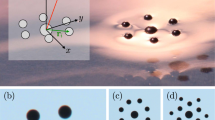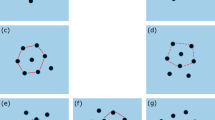Abstract
Spontaneous pattern formation by self-assembly is of long-standing1,2,3 and continuing interest4,5 not only for its aesthetic appeal6,7, but also for its fundamental8,9,10,11,12,13,14,15,16,17,18 and technological relevance19. So far, the study of self-organization processes has mainly focused on static structures, but dynamic systems20,21,22—those that develop order only when dissipating energy—are of particular interest for studying complex behaviour23,24. Here we describe the formation of dynamic patterns of millimetre-sized magnetic disks at a liquid–air interface, subject to a magnetic field produced by a rotating permanent magnet. The disks spin around their axes with angular frequency equal to that of the magnet, and are attracted towards its axis of rotation while repelling each other. This repulsive hydrodynamic interaction is due to fluid motion associated with spinning; the interplay between attractive and repulsive interactions leads to the formation of patterns exhibiting various types of ordering, some of which are entirely new. This versatile system should lead to a better understanding of dynamic self-assembly, while providing a test-bed for stability theories of interacting point vortices25,26,27,28 and vortex patches29.
This is a preview of subscription content, access via your institution
Access options
Subscribe to this journal
Receive 51 print issues and online access
$199.00 per year
only $3.90 per issue
Buy this article
- Purchase on Springer Link
- Instant access to full article PDF
Prices may be subject to local taxes which are calculated during checkout




Similar content being viewed by others
References
Mayer, A. M. Floating magnets. Nature 18, 258– 260 (1878).
Derr, L. A photographic study of Mayer's floating magnets. Proc. Am. Acad. Arts Sci. 44, 525–528 ( 1909).
Monckman, J. On the arrangement of electrified cylinders when attracted by an electrified sphere. Proc. Camb. Phil. Soc. 6, 179– 181 (1888).
Schecter, D. A., Dubin, D. H. E., Fine, K. S. & Driscoli, C. F. Vortex crystals from 2D Euler flow: experiment and simulation. Phys. Fluids 11, 905–914 (1999).
Bubeck, R., Bechinger C., Neser, S. & Leiderer, P. Melting and reentrant freezing of two-dimensional colloidal crystals in confined geometry. Phys. Rev. Lett. 82, 3364–3367 (1999).
Ghyka, M. The Geometry of Art and Life (Dover, New York, 1977 ).
Ball, P. The Self-Made Tapestry: Pattern Formation in Nature (Oxford Univ. Press, New York, 1999).
Whitesell, J. K. Organised Molecular Assemblies in the Solid State (Wiley, New York, 1999).
Philp, D. & Stoddart, J. F. Self-assembly in natural and unnatural systems. Angew. Chem. Int. Edn Engl. 35, 1155–1196 (1996).
Lounasmaa, O. V. & Thuneberg, E. Vortices in rotating superfluid 3He. Proc. Natl Acad. Sci. USA 96, 7760–7767 ( 1999).
Bowden, N., Brittain, S., Evans, A. G., Hutchinson, J. W. & Whitesides, G. M. Spontaneous formation of ordered structures in thin films of metals supported on an elastomeric polymer. Nature 393, 146–149 ( 1998).
Bowden, N., Choi, I. S., Grzybowski, B. A. & Whitesides, G. M. Mesoscale self-assembly of hexagonal plates using lateral capillary forces: synthesis using the “capillary bond”. J. Am. Chem. Soc. 121, 5373–5391 ( 1999).
Shinbrot, T. Competition between randomizing impacts and inelastic collisions in granular pattern formation. Nature 389, 574– 576 (1997).
Burns, M. M., Fournier, J. M. & Golovchenko, J. A. Optical matter—crystallization and binding in intense optical fields. Science 249, 749–754 (1990).
Murray, C. A. & Grier, D. G. Colloidal crystals—solid particles suspended in fluid form ordered arrays with unusual and useful physical properties. Am. Sci. 83, 238– 245 (1995).
Thompson, D'A. On Growth and Form (Dover, New York, 1992).
Shapiro, J. A. Thinking about bacterial populations as multicellular organisms. Annu. Rev. Microbiol. 52, 81–104 (1998).
Berg, H. & Budrene, E. O. Dynamics of formation of symmetrical patterns by chemotactic bacteria. Nature 376, 49–53 (1995).
GomezLopez, M., Preece, J. A. & Stoddart, J. F. The art and science of self-assembling molecular machines. Nanotechnology 7, 183–192 ( 1996).
Koschmieder, A. Benard Cells and Taylor Vortices (Cambridge Univ. Press, New York, 1993).
Jakubith, S., Rotermund, H. H., Engel, W., von Oertzen, A. & Ertl, G. Spatiotemporal concentration patterns in a surface reaction: propagating and standing waves, rotating spirals, and turbulence. Phys. Rev. Lett. 65, 3013– 3016 (1990).
Engelborghs, Y. Microtubules—dissipative structures formed by self-assembly. Biosens. Bioelectron. 9, 685–689 (1994).
Lindgren, K., Moore, C. & Nordahl, M. Complexity of two-dimensional patterns. J. Stat. Phys. 91, 909–951 (1998).
Singh, R., Maru, V. M. & Moharir, P. S. Complex chaotic systems and emergent phenomena. J. Nonlinear Sci. 8, 235–259 (1998).
Havelock, T. H. The stability of motion of rectilinear vortices in ring formation. Phil. Mag. 11, 617–633 ( 1931).
Morton, W. B. Vortex polygons. Proc. R. Irish Acad. A 42, 21–29 (1935).
Aref, H. & Vainchtein, D. L. Point vortices exhibit asymmetric equilibria. Nature 392, 769– 770 (1998).
Thomson, J. J. A Treatise on the Motion of Vortex Rings (Macmillan, London, 1883).
Dritschel, D. G. The stability and energetics of corotating uniform vortices. J. Fluid Mech. 157, 95–134 (1985).
Schonberg, J. A. & Hinch, E. J. Inertial migration of a sphere in Poiseuille flow. J. Fluid Mech. 203, 517–524 (1989).
Acknowledgements
This work was supported by DARPA and NSF.
Author information
Authors and Affiliations
Corresponding author
Supplementary Information
Rights and permissions
About this article
Cite this article
Grzybowski, B., Stone, H. & Whitesides, G. Dynamic self-assembly of magnetized, millimetre-sized objects rotating at a liquid–air interface. Nature 405, 1033–1036 (2000). https://doi.org/10.1038/35016528
Received:
Accepted:
Issue Date:
DOI: https://doi.org/10.1038/35016528
This article is cited by
-
Pattern formation by turbulent cascades
Nature (2024)
-
Diverse behaviors in non-uniform chiral and non-chiral swarmalators
Nature Communications (2023)
-
Simultaneous emergence of active turbulence and odd viscosity in a colloidal chiral active system
Communications Physics (2023)
-
Microrobot collectives with reconfigurable morphologies, behaviors, and functions
Nature Communications (2022)
-
Odd dynamics of living chiral crystals
Nature (2022)
Comments
By submitting a comment you agree to abide by our Terms and Community Guidelines. If you find something abusive or that does not comply with our terms or guidelines please flag it as inappropriate.



